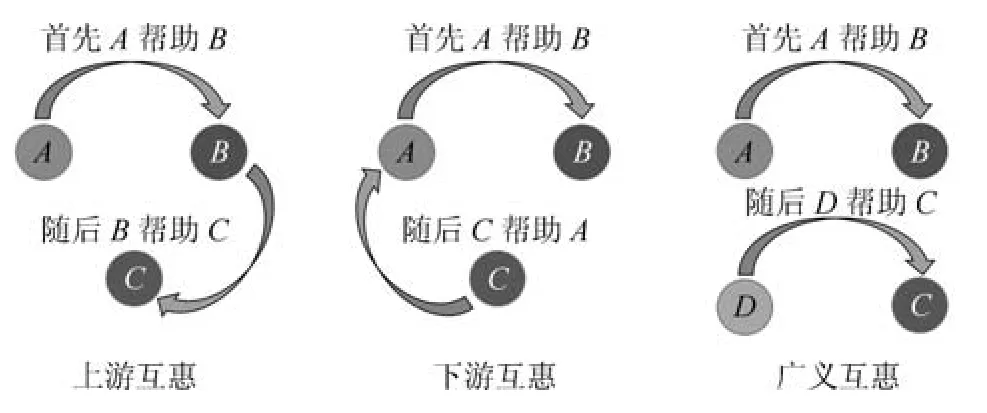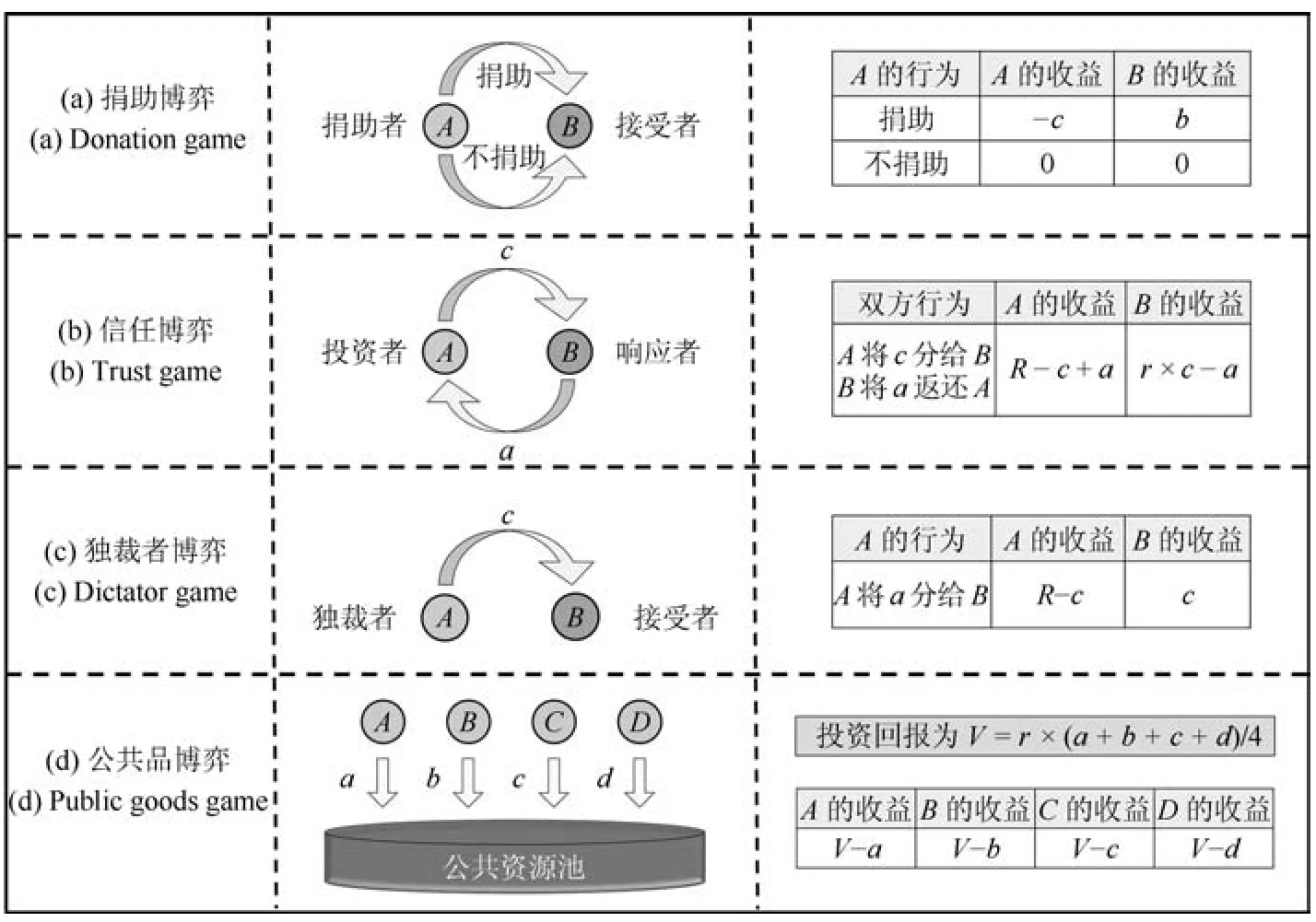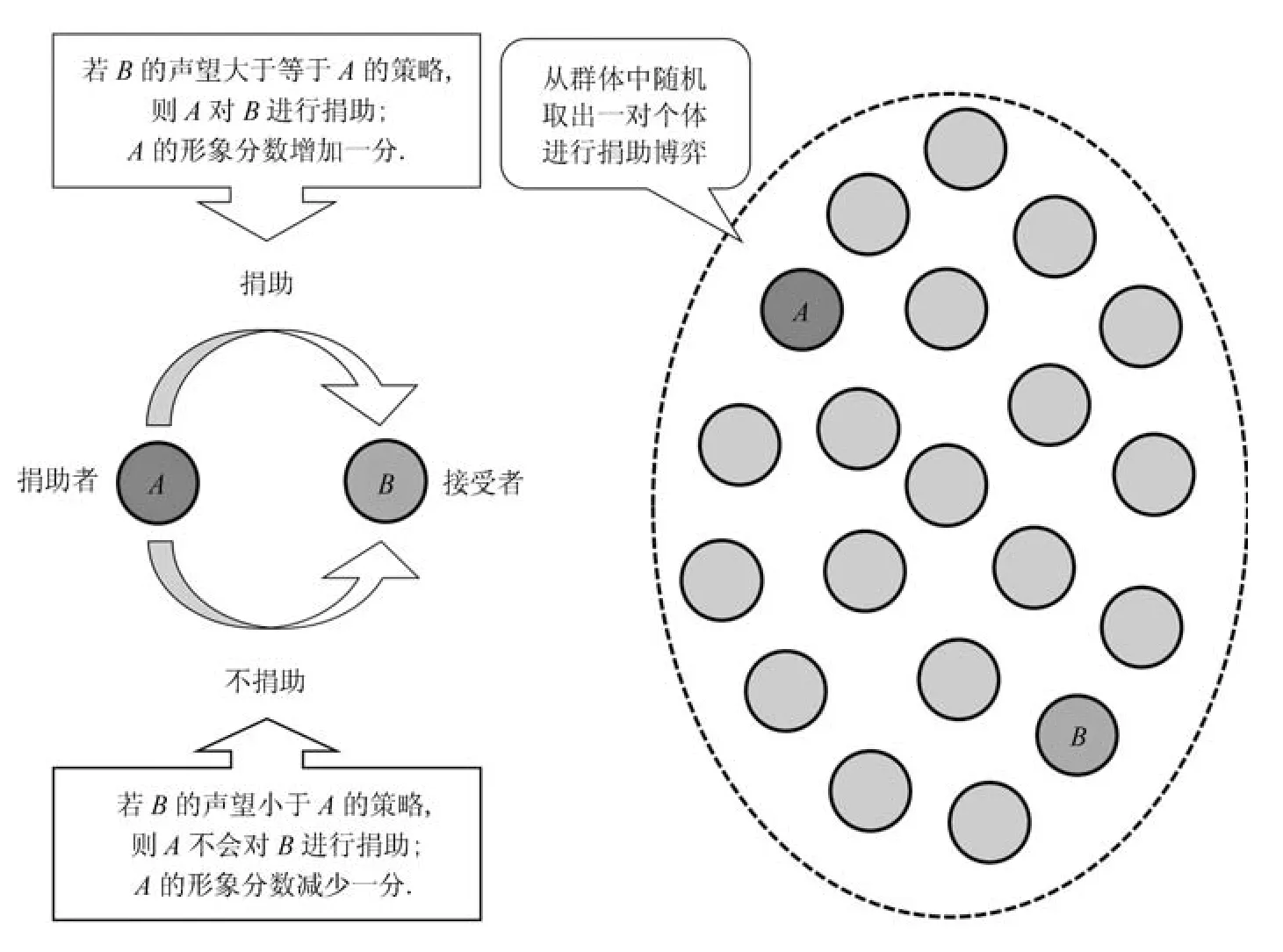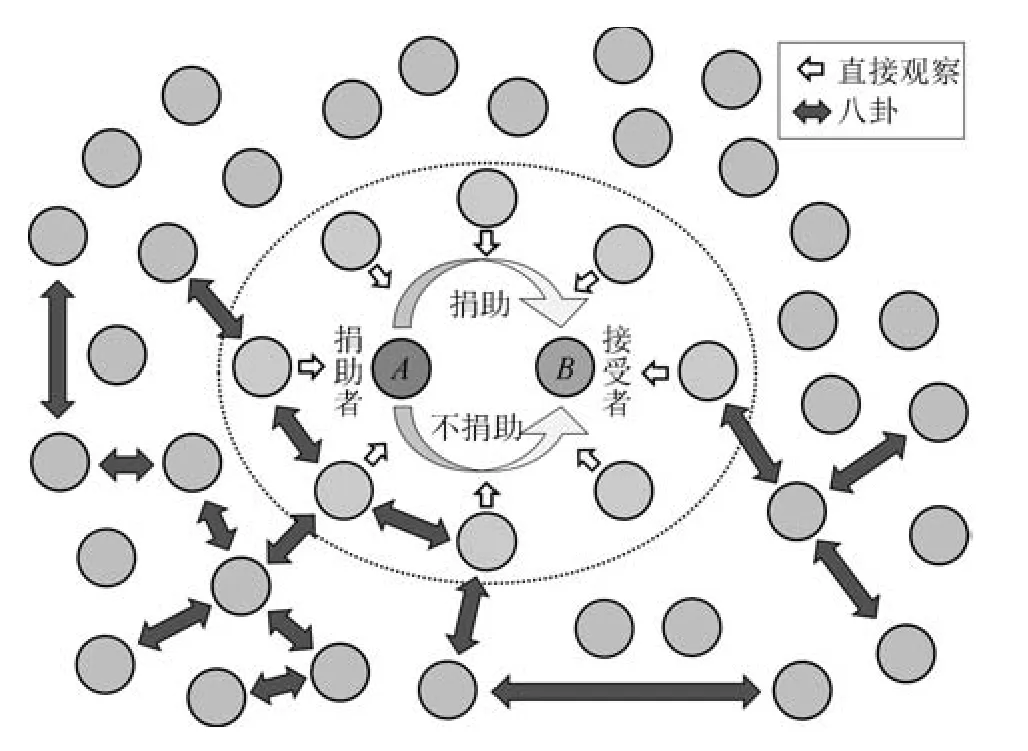间接互惠与合作演化的若干问题研究进展
2018-03-10张艳玲刘爱志孙长银
张艳玲 刘爱志 孙长银
达尔文的进化论认为“物竞天择、适者生存”,说明竞争在进化中起核心的作用[1].依据这一理论,在“弱肉强食”的生存斗争中,适应性强的个体胜出,适应性差的个体被淘汰.从而在激烈的生存斗争中,每个个体均会从自身利益出发,变得利己自私、唯利是图.然而,从细菌群落到蜂群蚁群,从狼群狮群围捕猎物到群居的大猩猩,再到复杂而有序的人类社会,合作行为无处不在[1−4].显然,帮助对手会降低自身的适应度,从而削弱自身的竞争优势,合作的存在看似并不合理.面对广泛存在的合作行为,达尔文本人也深感困惑,在其著作中相应的解释只是一笔带过[5].
合作行为广泛存在,同时在很多领域中又十分匮乏.研究促进合作涌现的机制有以下三点益处:1)有助于解释众多产生原因未知的现象,例如,细胞的癌变[6]、语言的产生[7]和集群行为[8];2)有助于解决我们面临的全球性问题,例如,“公地悲剧”[9]、环境恶化[10]和资源枯竭[11];3)有助于破解互联网时代在虚拟世界中我们遇到的新问题,例如,网络欺诈[12]等违法犯罪行为.由此可见,研究促进合作演化的机制对人类发展有着重大的现实意义和时代紧迫感.
如何研究合作行为的演化?这是一个热点问题,2005年Science杂志就指出“合作行为如何进化”是21世纪最关键的25个科学问题之一[13].演化博弈论(Evolutionary game theory)为研究合作的演化提供一个有力的数学框架.Smith等首次将von Neumann开创的博弈论观点(大脑在利益冲突时做出理性决定)扩展为根据自然选择而得出决定[14],这标志着演化博弈论的开创.近年来,国内外越来越多的学者利用此理论研究促进合作涌现的机制[15−37].其中最著名的是哈佛大学的Nowak教授,他对“综合进化论”(这一理论将突变、选择和进化的基本概念整合到一个数学框架中)的思想进行了扩展,将囚徒困境放到演化的群体中进行研究.Nowak首次总结了促进合作涌现的5大机制[38]:亲缘选择(Kin selection)、直接互惠(Direct selection)、间接互惠(Indirect selection)、网络互惠(Network reciprocity)和群组选择(Group selection).亲缘选择意味着,与谁的血缘关系越近,就越倾向与之合作;直接互惠意味着,今天我帮助你,明天你会帮助我;间接互惠意味着,今天我帮助你,明天会有他人帮助我;网络互惠意味着,个体仅仅与邻居进行博弈,合作者团簇最终胜出背叛者团簇;群组选择意味着,竞争既发生在个体之间,也发生在群组之间.除了这5大机制,最近的综述还归纳出另外5种促进合作演化的机制[39]:绿胡子选择(Green beard selection)、强互惠性(Strong reciprocity)、有成本的示好(Costly signaling)、集合选择(Set selection)和选择性参与(Optional participation).绿胡子选择意味着,相似性越高的个体之间越容易发生合作;强互惠性意味着,个体愿意牺牲自身利益惩罚背叛行为;有成本的示好意味着,个体愿意承担成本吸引其他个体的关注;集合选择意味着,个体仅仅与相同集合的个体进行交互;选择性参与意味着,个体有权利拒绝与特定个体进行博弈.
1 关于间接互惠的概述
1.1 研究间接互惠的意义
间接互惠是促进合作涌现的重要机制之一.相对于直接互惠,间接互惠不再要求相同的个体间重复相遇,同时利他个体能够从第三方获得收益,这可以很好地解释陌生个体间的合作行为[40−46].大量的非亲缘、非直接的间接互惠行为在人类社会和动物世界中广泛存在.特别地,人类社会中语言的出现[7,47]、道德规范的形成[38]、社会的分工[39]以及人类大脑的发育[47]都与间接互惠密不可分.在经济全球化和进入网络时代的背景下,电子商务大大地增加了陌生个体间交易的频率,陌生个体间的一次性交互逐步取代传统的相识个体间的重复交互[37,48−52].此时的交易主要依赖于声望和信任,从而局部信息条件下个体信任被利用的“道德风险”不断增大[45].因此,针对间接互惠如何促进合作涌现的研究吸引了演化生物学家、经济学家和社会科学家等学者的极大兴趣.
1.2 间接互惠的分类和研究方法
间接互惠包括 “上游互惠”(Upstream reciprocity)、“下游互惠”(Downstream reciprocity)和 “广义互惠”(Generalized reciprocity)三种形式[45,53−57].如图1所示,“上游互惠”指的是,B得到A的帮助后受到激励,继而帮助C;“下游互惠”指的是,C观察到A曾经帮助了B,因此帮助A,这是一种建立在声望基础上的间接互惠;“广义互惠”指的是,D观察到A帮助B,于是D帮助C.“上游互惠”并不能单独促进合作的涌现,只有与直接互惠或者网络互惠相结合才能促进合作的涌现[56−57].“下游互惠”和“广义互惠”均可单独促进合作的涌现,不过前者是研究间接互惠的主流方向,而关于后者的相关研究还甚少.目前,针对间接互惠的研究方法主要有理论分析、蒙特卡罗仿真(Monte Carlo simulation)和实验验证(包括实验室实验、实地实验和在线实验).

图1 间接互惠的三种形式Fig.1 Three kinds of indirect reciprocity
接下来的文章从以下三方面归纳总结关于“下游互惠”的研究:经典的博弈模型、声望评估准则与行为准则和基于八卦的声望信息传播.
2 经典的博弈模型
在演化博弈论框架下研究间接互惠,需要将个体之间发生的交互行为抽象为博弈模型. 目前,常被用来研究间接互惠的博弈模型包括捐助博弈(Donation game)[43−44,58−72]、信任博弈(Trust game)[73−75]、独裁者博弈(Dictator game)[76−82]和公共品博弈(Public goods game)[83−88].
1)捐助博弈,如图2(a)所示.一方为捐助者A,另一方为接受者B:如果A给予B捐助,则A付出成本c且B得到收益b(b>c);如果A不给予B捐助,则双方均未获得收益且没有损失.
2)信任博弈,如图2(b)所示.一方为投资者A,另一方为响应者B:A将部分资金c(总额为R, 0≤c≤R)给予B,从而B获得收益r×c(r>1);随后,B决定将其获得的部分收益a(0≤a≤r×c)返还给A.最后,A获得收益R−c+a,B获得收益r×c−a.
3)独裁者博弈,如图2(c)所示.一方为独裁者A,另一方为接受者B:A将部分资金c(总额为R, 0≤c≤R)分给B.无论A给了B多少,B只能接受,没有拒绝的权利,从而B得到收益c,而A获得其余收益R−c.
4)公共品博弈,如图2(d)所示.博弈的成员同时向公共资源池进行投资,投资总额乘以增益系数r(1<r<博弈人数)后平均分配给所有博弈成员,每个成员的收益为所获得的回报减去自身的投资额.
3 声望评估准则与行为准则
3.1 常见的声望评估准则及其相关研究
声望是间接互惠发挥作用的核心,然而声望的建立首先面临的问题是如何评价个体声望的好与坏,即如何构建声望评估准则.目前,被广泛研究的评估准则包括“一阶评估”、“二阶评估”和“三阶评估”[43−44,59−71,85−101],如表1所示.
“一阶评估”在评价个体声望时仅考虑捐助者行为(是否给予帮助).经典的“一阶评估”是“形象分数”:当捐助者帮助接受者时,捐助者的形象分数增加一分;当捐助者拒绝帮助接受者时,捐助者的形象分数减少一分.1998年,Nowak等首次利用“形象分数”构建了刻画间接互惠的数学模型,如图3所示.他们认识到间接互惠在促进合作演化方面的巨大作用[43]:当玩家的声望由多值“形象分数”确定时,蒙特卡罗仿真表明合作行为在群体中以较高频率涌现.之后,这个结论被行为实验证实[63].与此同时,Nowak等理论分析了二值“形象分数”[43−44].稍后的理论研究表明很多因素导致合作行为在采取二值“形象分数”的群体中消失[64−66,96].这种现象是由于此准则固有的困境:拒绝帮助形象差的玩家,虽然惩罚了他们,但同时也令自身形象变差[67,97−98].显然,仅考虑捐助者行为的二值“形象分数”会造成不公正的声望评价.最近,理论工作揭示了多人博弈[68,99]、三值“形象分数”(好、中性、坏)[69]或特定“一阶评估”(观察者根据捐赠者在以往多次行动中的表现确定其名声)[70,100]可以克服这个困境,促进合作行为的涌现.

图2 博弈模型及收益矩阵Fig.2 Games and their payoあmatrices

表1 声望评估准则Table 1 Reputation evaluation criterion

图3 经典的间接互惠模型Fig.3 Representative model about indirect reciprocity
“二阶评估”也能弥补二值“形象分数”固有的缺陷:在评价个体声望时,不仅考虑捐助者的行为(是否给予捐助),还要考虑接受者的声望(好、坏).典型的“二阶评估”包括“温和准则”和“严苛准则”,如表2所示.二者唯一的不同点在于,前者认为拒绝帮助坏人会为捐助者带来好的声望,而后者认为此行为会为捐助者带来坏的声望.学者在“二阶评估”中引入惩罚策略(不仅给被惩罚者带来损失,而且惩罚者也要承担少量损失),发现对背叛者置之不理比惩罚背叛者更有利于合作的涌现[71].
在“二阶评估”基础上,额外考虑捐赠者的声望,这种评估准则被称为“三阶评估”[91−92].例如,名声差的人通过帮助好名声之人“收买”好名声.学者考察所有可能的“三阶评估”,假设群体最多拥有两种策略,发现了8种评估准则可以令合作行为具有演化稳定性[93].这8种准则如表3所示,具有一些共性:与好人合作(捐助)其名声为好,而背叛好人(不捐助)则为坏,同时好人背叛坏人不会损坏名声.值得一提的是,它们均不属于“一阶评估”,而其中两种属于“二阶评估”,分别为“温和准则”和“严苛准则”.学者在群体共存多种策略的假设下对这两种准则进行研究[94].上述研究均假设群体共享相同评估准则,而比较的是不同行为准则的竞争.鉴于认知差异会导致个体对于如何评估声望的理解不同,学者也考虑了评估准则因人而异的情形[95,101].

表2 典型的“二阶评估”Table 2 Representative“second-order evaluation”

表3 8种促进合作演化的声望评估准则Table 3 Eight reputation evaluation criterions which favor the evolution of cooperation
3.2 常见的行为准则及其相关研究
关于间接互惠的早期研究假设个体仅帮助声望好的个体,或者个体仅帮助形象分数高于某一阈值的个体[43−44,64−68,96−99]. 这些最简单的行为准则(行为准则是能否捐助的依据)要求个体仅根据对手的声望决定自己是否给予捐助.稍后,略微复杂的行为准则,例如个体决定是否捐助时需要同时考虑自身和对手的声望,受到关注[69−71,89−90,94−95,100−101]. 上述研究主要关注哪
种声望评估准则更有利于合作的演化.最近,学者们对较为复杂的行为准则如何影响合作涌现进行了探索[72,87,102].一些学者考察个体在决定是否捐助时对接受者的声望有一定的容忍范围(当接受者的声望在这个范围内则进行捐助),通过仿真发现,一定的声望容忍度有助于合作的涌现[87,102].还有一些研究提出了一种基于向量的行为准则(捐助者将自身声望与接受者声望进行比较,当至少满足三种条件中的两种时则进行捐助,这三种条件包括声望近似、声望高于自己和声望低于自己),通过仿真发现,“捐赠者会为与自己声望近似或者高于自己声望的接受者进行捐助”这种策略在较小的成本收益比下能够成为占优策略,同时促进合作的演化[72].
4 基于八卦的声望信息传播
直接观察和八卦(个体之间通过交流,共享彼此的声望信息)是声望信息传播的两种方式[45,103−104],如图4所示.当群体规模较小时,个体可以通过直接交互或者直接观察获得对方一手的声望信息.然而随着群体规模的扩大,直接观察到所有个体行为变得不大可能,必须通过与第三方交流来分享和传播二手的声望信息[104−105].可见在较大的群体中,八卦常常是声望信息传播的主要方式.
4.1 关于八卦的解析研究和仿真研究
一些学者通过解析和仿真的方式对于八卦如何影响合作的涌现进行研究.此时的模型通常假设观察者以一定的概率q了解玩家的声望(通过概率的形式简单模拟了声望的局部传播).针对“形象分数”,Nowak等给出了简单的数学关系:当q高于成本收益比c/b时,合作可以涌现[43−44].在“二阶评估”下,类似的条件在两个调查中获得[106−107],这两个调查最大区别在于,当观察者未看到交互过程时,捐赠者的名声保持不变或者设定为未知.若将交互划分为公开和私下两种(观察者一直看到公开交互而以概率q看到私下交互),类似的条件仍然满足[108].上述研究均假设q为常数,针对q随时间推移而增大的情形(观察者越来越可能了解其余个体的声望),也有学者进行了理论分析[109].

图4 声望信息传播的两种方式Fig.4 Two ways of reputation dispersal
八卦在传播声望信息过程中可能受到噪声的干扰和谎言的入侵,导致不公正的声望评价.噪声一方面来源于不完整的观察给出不公正的声望,另一方面来源于在声望传播过程中无意地误导他人;而谎言则是故意传播虚假的声望信息而对他人进行误导.一项研究在声望传播中引入欺骗策略(传播虚假声望信息),发现这种策略在没有其他机制的情形下导致群体合作演化的失败[110].另两项研究表明:当群体中没有虚假信息传播时,八卦数量的增加有助于促进合作的演化;而存在噪声干扰和谎言所导致的不公正评价时,中等数量的八卦最有利于促进合作的演化[111−112].这两项研究是基于累加的八卦信息进行决策,而最近的研究发现基于最新的八卦信息作出决策更能促进合作的演化[113].上述关于八卦的模型均没有加入声望传播所需的成本(例如时间的消耗).当考虑这种成本时,结果表明间接互惠不再促进合作的演化[114].
4.2 关于八卦的实验研究
另一部分学者通过行为实验的方法对八卦进行研究,主要发现如下.即使个体能够通过直接交互或者直接观察获取他人的一手声望信息,实验发现个体也会倾向于基于八卦信息做出判断[115−117].八卦所传播的声望信息有助于个体甄别合作对象从而避免被欺骗,并有效提高群体的合作水平[88,103,118].当八卦将个体的声望传播到未来会与其发生交互的个体时,八卦可以促使个体更加关注自身声望并促进慷慨行为的产生[82,119−121].八卦按照传播主题可以被划分为传播好名声和传播坏名声两种,传播好名声的八卦更能够促进合作的涌现[115].社会网络结构允许个体可以在不同时间从多个来源获取彼此的声望信息,这有助于减少信息传播中可能出现的误差[122−123].“道德威慑”通过拆穿谎言后的惩罚机制维护八卦的可信性,从而促进合作的涌现[124].当声望被视为可以买卖的物品时,由于人类具有认知和辨别能力以及欺骗者为了购买声望会付出一定的收益而降低适应度,因此,虚假的声望对合作水平的影响并不明显[125−126].
5 总结
合作行为在很多领域中十分匮乏,因此,研究促进合作演化的机制对人类发展有着重大的现实意义和时代紧迫感.2005年Science杂志就指出“合作行为如何进化”是21世纪最关键的25个科学问题之一.在演化博弈论的框架下,研究人员已提出一些促进合作演化的机制,其中间接互惠是促进合作演化的最重要机制之一,并已吸引了演化生物学家、经济学家和社会学家等学者的极大兴趣.它包括“上游互惠”、“下游互惠”和“广义互惠”三种方式:“上游互惠”并不能单独促进合作的涌现,只有与直接互惠或者网络互惠相结合才能促进合作的涌现;“下游互惠”和“广义互惠”均可单独促进合作的涌现,不过前者是研究间接互惠的主流方向,而关于后者的相关研究还甚少.本文关注的是以声望为核心的“下游互惠”,具体而言,个体通过帮助他人建立自己在群体中的好声望,从而期待未来获得他人的帮助.
本文从三个方面对关于“下游互惠”的研究进行总结.首先,回顾了在演化博弈论框架下研究间接互惠的博弈模型:捐助博弈、信任博弈、独裁者博弈和公共品博弈.其次,回顾了被广泛研究的三类声望评估准则:“一阶评估”、“二阶评估”和“三阶评估”.相关研究假设采用比较简单的行为准则,而聚焦于哪种声望评估准则能够促进合作的演化.同时回顾了关于较为复杂的行为准则如何促进合作演化的一些研究.再次,回顾了利用解析方法和仿真方法对八卦如何促进合作演化进行的研究.解析研究一般假设个体以一定的概率获得彼此的声望信息,这个概率通常为常值,个别研究假设其可随时间变化.仿真研究假设更加复杂的模型,例如八卦不再如实传递信息,而是融入了噪声和谎言.同时也回顾了利用行为实验对八卦进行的研究,内容十分宽泛.
6 未来展望
基于声望的间接互惠具有广阔的研究前景,其未来可能的研究方向有复杂网络上的间接互惠、声望传播系统的鲁棒性、声望共享系统的建立和间接互惠在P2P网络中的应用.
6.1 复杂网络上的间接互惠
目前,大部分理论研究均是在混合均匀群体中获得的[127−129].然而,绝大多数现实社会中的群体并非混合均匀的,个体之间的交互和声望传播都是利用复杂网络实现的.在演化博弈论框架下,未涉及间接互惠的静态复杂网络和动态复杂网络已被广泛研究[130−142],而只有较少研究关注复杂网络上的间接互惠[143−147].文献[143]发现在社会网络中,根据声望选择交互伙伴这种行为有助于促进合作的演化.文献[144−145]假设小世界网络和无标度网络等复杂网络可以重构(断边重连),发现声望共享“联盟”的存在有助于促进群体合作.文献[146−147]假设直接互惠和间接互惠同时存在于网络上,发现间接互惠有助于刻画现实社会的无标度网络的形成.
虽然科研人员已经对于复杂网络上的间接互惠进行了一些初步的探索,但是还有很多问题需要进一步研究.例如,上述研究均认为声望是通过观察获得的公共信息(即声望全局可知),然而在现实社会中,声望多数情况下是通过八卦进行传播的,由此可见,静态或动态复杂网络上八卦这种声望传播方式如何影响合作的演化是一个值得深入研究的方向.
6.2 声望传播系统的鲁棒性
八卦是大规模群体中声望传播的主要方式,它在传播声望信息过程中可能受到噪声的干扰和谎言的入侵,从而导致不公正的声望评价.噪声一方面来源于不完整的观察给出不公正的声望,另一方面来源于在声望传播过程中无意地误导他人;而谎言则是故意传播虚假的声望信息而对他人进行误导.一项研究在声望传播中引入欺骗策略(传播虚假声望信息),发现这种策略在没有其他机制的情形下导致群体合作演化的失败[110].另两项研究表明:当群体中没有虚假信息传播时,八卦数量的增加有助于促进合作的演化;而存在噪声干扰和谎言所导致的不公正评价时,中等数量的八卦最有利于促进合作的演化[111−112].这两项研究是基于累加的八卦信息进行决策,而最近的研究发现基于最新的八卦信息作出决策更能促进合作的演化[113].
科研人员已经对于加入噪声和谎言的八卦进行了初步的探索,但已研究的模型还有很多可以改进的地方,相应的结果并不全面.在未来的研究中,我们需要建立更加合适的模型,结合现实生活提出能够抵抗噪声干扰和谎言入侵的八卦,令声望传播系统具有鲁棒性,进而发现能够促进合作演化且强抗干扰的机制.
6.3 声望共享系统的建立
以往关于间接互惠的绝大多数研究均没有考虑个体间声望共享所需的成本.但在实际中,人们在评价和分享他人声望的过程中需要耗费时间和精力.例如,在网络购物平台中,人们需要花费时间和精力去评价所购买的产品或者服务.近期的一项研究表明,当考虑声望共享所需成本时,间接互惠无法促进合作的涌现[114].
随着经济全球化和网络时代的到来,陌生个体间的交易日益频繁.为什么人们会不计成本、不厌其烦地和陌生人分享他人的真实声望呢?目前的研究还没有给出一个满意的答复.因此,我们需要针对考虑声望共享所需成本的模型,提出能够建立声望共享系统且促进合作涌现的有效机制.
6.4 间接互惠在P2P网络中的应用
近年来,P2P(Peer to peer)网络应用广泛,因此对其研究发展快速.在P2P网络中,参与者共享自身所拥有的一部分硬件资源(存储能力、网络连接能力和打印机等),这些共享资源通过网络提供服务和内容,能被其他对等节点(Peer)直接访问而无需经过中间实体.在此网络中的参与者既是资源、服务和内容的提供者(Server),又是资源、服务和内容的获取者(Client).合作是确保所有参与者获得所需服务的关键,出于恶意和自私的非合作行为往往导致参与者获得较少服务甚至一无所获.消除非合作行为的有效机制包括信任机制和激励机制.信任机制指的是根据参与者的交互历史计算他的可信任值[148−153],例如,eBay声望系统[151]、Beta声望系统[152]、Eigentrust声望系统[148]和Powertrust声望系统[153].激励机制包括金钱激励和非金钱激励[154−157].
鉴于 P2P网络中个人利益和集体利益相冲突,经典博弈理论已被广泛用来研究此类网络[154,157−160].不过经典博弈理论假设参与者完全理性且拥有全局信息.这些假设并不现实,同时经典博弈理论不能描述参与者策略的动态演化过程及策略在整个系统中的传播过程.近来,可以克服上述缺点的演化博弈论被用来研究P2P网络[155,161−165].文献[161]假设P2P网络是混合均匀且有无限节点,并利用复制动力学研究三种激励机制的稳定性.文献[162]同样利用复制动力学发现一种延拓的模仿动力学可以改进整个网络路径选择的效率,从而避免路径上的过载或长延迟.文献[163]假设P2P网络具有有限节点,分别在混合均匀网络和同型结构网络上研究一种激励机制(Reciprocation-based incentive mechanism).文献[164]将关于同类激励机制的研究推广到异型结构的P2P网络.文献[155,165]假设P2P网络具有有限节点,利用计算机仿真调查两种信任机制.上述研究是针对一般性的P2P网络,还有一些研究利用演化博弈论分析特殊的P2P网络,例如基于P2P的无线传感网络[166−169]和基于P2P的车辆自组织网络[170].
科研人员已利用演化博弈论对P2P网络进行了一些探索,本文主体部分总结了在演化博弈论框架下对于间接互惠的研究成果,一个自然的想法是将这些研究思路应用到关于P2P网络的研究中.大体思路有以下4点:
1)声望评估准则可视作信任机制.将“一阶评估”、“二阶评估”或“三阶评估”作为信任机制集合,寻找能够令P2P网络中合作行为稳定的信任机制.
2)行为准则可视为激励机制.将已研究过的行为准则构成激励机制集合,寻找能够令P2P网络高效、有序运行的激励机制.
3)在P2P网络的声望传播过程中融入八卦,研究八卦对于网络稳定性的影响.
4)可以将深度学习方法[171]与间接互惠机制结合,来研究网络控制问题[172−174].
致谢
对北京科技大学自动化学院刘剑、孟祥钰、古鹏飞和王雷等同学给予的帮助表示感谢!
1 Darwin C.On the origin of species by means of natural selection.Science,1963,71(6):354−357
2 McDonald D B.Cooperation among animals:an evolutionary perspective.Lee Alan Dugatkin.The Quarterly Review of Biology,1998,73(3):387−388
3 Nowak M A,Sigmund K.Evolutionary dynamics of biological games.Science,2004,303(5659):793−799
4 Clutton-Brock T.Cooperation between non-kin in animal societies.Nature,2009,462(7269):51−57
5 Darwin C.The Works of Charles Darwin,Volume 15:On the Origin of Species 1859.New York:New York University Press,2010.69−83
6 Axelrod R,Axelrod D E,Pienta K J.Evolution of cooperation among tumor cells.Proceedings of the National Academy of Sciences of the United States of America,2006, 103(36):13474−13479
7 Smith E A.Communication and collective action:language and the evolution of human cooperation.Evolution and Human Behavior,2010,31(4):231−245
8 Tuyls K,Parsons S.What evolutionary game theory tells us about multiagent learning.Arti fi cial Intelligence,2007, 171(7):406−416
9 Hardin G.The tragedy of the commons.Science,1968, 162(3859):1243−1248
10 Milinski M,Sommerfeld R D,Krambeck H J,Reed F A, Marotzke J.The collective-risk social dilemma and the prevention of simulated dangerous climate change.Proceedings of the National Academy of Sciences of the United States of America,2008,105(7):2291−2294
11 Requejo R J,Camacho J.Evolution of cooperation mediated by limiting resources:connecting resource based models and evolutionary game theory.Journal of Theoretical Biology, 2011,272(1):35−41
12 Zhang Y,He J H.Research on the mobile net business knowledge sharing strategy of fraud evade.Applied Mechanics and Materials,2014,631−632:1171−1173
13 Pennisi E.How did cooperative behavior evolve?Science, 2005,309(5731):93
14 Smith J M,Price G R.The logic of animal con fl ict.Nature, 1973,246(5427):15−18
15 Fu F.Evolutionary Games and Evolution of Cooperation [Ph.D.dissertation],Peking University,China,2009.
16 Chen X J.Evolutionary Dynamics of Cooperation in Complex Networks[Ph.D.dissertation],Peking University, China,2010.
17 Wu B.Evolutionary Game Dynamics in Finite Populations [Ph.D.dissertation],Peking University,China,2011.
18 Wang J.Evolutionary Game Dynamics in Populations [Ph.D.dissertation],Peking University,China,2011.
19 Zhang C Y.Cooperation in Evolutionary Games on Networks of Agents[Ph.D.dissertation],Peking University, China,2012.
20 Zhang J L.Cooperation Mechanisms in Evolutionary Games [Ph.D.dissertation],Peking University,China,2013.
21 Wu T.Evolutionary Cooperation Dynamics[Ph.D.dissertation],Peking University,China,2013.
22 Yang Z H.Evolutionary Games and Evolutionary Cooperation Dynamics in Complex Networks[Ph.D.dissertation], Xidian University,China,2014.
23 Zhang Y L.Two Theoretical Methods upon the Evolution of Cooperation in Finite Populations and the Applications [Ph.D.dissertation],Peking University,China,2015.
24 Cong R.Coevolutionary Games on Complex Networks [Ph.D.dissertation],Xidian University,China,2014.
25 Du J M.Evolutionary Game Dynamics in Complex Systems [Ph.D.dissertation],Xidian University,China,2016.
26 Li K.Evolutionary Dynamics in Collective Behavior[Ph.D. dissertation],Peking University,China,2016.
27 Wang Long,Fu Feng,Chen Xiao-Jie,Wang Jing,Li Zhuo-Zheng,Xie Guang-Ming,Chu Tian-Guang.Evolutionary games on complex networks.CAAI Transactions on Intelligent Systems,2007,2(2):1−10 (王龙,伏锋,陈小杰,王靖,李卓政,谢广明,楚天广.复杂网络上的演化博弈.智能系统学报,2007,2(2):1−10)
28 Wang Long,Fu Feng,Chen Xiao-Jie,Wang Jing,Wu Bin,Chu Tian-Guang,Xie Guang-Ming.Collective decisionmaking over complex networks.CAAI Transactions on Intelligent Systems,2008,3(2):95−108 (王龙,伏锋,陈小杰,王靖,武斌,楚天广,谢广明.复杂网络上的群体决策.智能系统学报,2008,3(2):95−108)
29 Wang Long,Wang Jing,Wu Bin.Quantum games:new methodologies and strategies.CAAI Transactions on Intelligent Systems,2008,3(4):294−304 (王龙,王靖,武斌.量子博弈:新方法与新策略.智能系统学报, 2008,3(4):294−304)
30 Wang Long,Wu Te,Zhang Yan-Ling.Feedback mechanism in coevolutionary games.Control Theory&Applications, 2014,31(7):823−836 (王龙,吴特,张艳玲.共演化博弈中的反馈机制.控制理论与应用, 2014,31(7):823−836)
31 Boccabella A,Natalini R,Pareschi L.On a continuous mixed strategies model for evolutionary game theory.Kinetic&Related Models,2011,4(1):187−213
32 Salimi Sartakhti J,Manshaei M H,Sadeghi M.MMP-TIMP interactions in cancer invasion: an evolutionary gametheoretical framework.Journal of Theoretical Biology,2017, 412:17−26
33 Perc M,Jordan J J,Rand D G,Wang Z,Boccaletti S,Szolnoki A.Statistical physics of human cooperation.Physics Reports,2017,687:1−51
34 Wang Z,Jusup M,Wang R W,Shi L,Iwasa Y,Moreno Y,Kurths J.Onymity promotes cooperation in social dilemma experiments.Science Advances,2017,3(3):Article No.e1601444
35 Allen B,Lippner G,Chen Y T,Fotouhi B,Momeni N,Yau S T,Nowak M A.Evolutionary dynamics on any population structure.Nature,2017,544(7649):227−230
36 Taylor C,Nowak M A.Transforming the dilemma.Evolution,2007,61(10):2281−2292
37 Rand D G,Nowak M A.Human cooperation.Trends in Cognitive Sciences,2013,17(8):413−425
38 Nowak M A.Five rules for the evolution of cooperation.Science,2006,314(5805):1560−1563
39 Zaggl M A.Eleven mechanisms for the evolution of cooperation.Journal of Institutional Economics,2014,10(2): 197−230
40 Boyd R,Richerson P J.The evolution of indirect reciprocity.Social Networks,1989,11(3):213−236
41 Wedekind C.Give and ye shall be recognized.Science,1998, 280(5372):2070−2071
42 Ferri´ere R.Evolutionary biology:help and you shall be helped.Nature,1998,393(6685):517−519
43 Nowak M A,Sigmund K.Evolution of indirect reciprocity by image scoring.Nature,1998,393(6685):573−577
44 Nowak M A,Sigmund K.The dynamics of indirect reciprocity.Journal of Theoretical Biology,1998,194(4): 561−574
45 Nowak M A,Sigmund K.Evolution of indirect reciprocity.Nature,2005,437(6685):1291−1298
46 Wedekind C,Braithwaite A V A.The long-term bene fi ts of human generosity in indirect reciprocity.Current Biology, 2002,12(12):1012−1015
47 Gardenfors P.Games,Actions and Social Software.Berlin: Springer-Verlag,2012.164−183
48 Resnick P,Kuwabara K,Zeckhauser R,Zeckhauser R,Friedman E.Reputation systems.Communications of the ACM, 2000,43(12):45−48
49 Bolton G E,Katok E,Ockenfels A.How eあective are electronic reputation mechanisms?An experimental investigation.Management Science,2004,50(11):1587−1602
50 Resnick P,Zeckhauser R,Swanson J R,Lockwood K.The value of reputation on eBay:a controlled experiment.Experimental Economics,2006,9(2):79−101
51 Geunes J,Ak¸cali E,Pardalos P M,Romeijn H E,Shen Z J M.Applications of Supply Chain Management and E-Commerce Research.Boston: Springer-Verlag,2005. 195−216
52 Lucking-Reiley D,Bryan D,Prasad N,Reeves D.Pennies from eBay:the determinants of price in online auctions.The Journal of Industrial Economics,2007,55(2):223−233
53 Greiner B,Levati M V.Indirect reciprocity in cyclical networks:an experimental study.Journal of Economic Psychology,2003,26(5):711−731
54 Pfeiあer T,Rutte C,Killingback T,Taborsky M,Bonhoeffer S.Evolution of cooperation by generalized reciprocity.Proceedings of the Royal Society B,2005,272(1568): 1115−1120
55 Chiong R,Kirley M.Promotion of cooperation in social dilemma games via generalised indirect reciprocity.Connection Science,2015,27(4):417−433
56 Nowak M A,Roch S.Upstream reciprocity and the evolution of gratitude.Proceedings of the Royal Society B,2007, 274(1610):605−610
57 Iwagami A,Masuda N.Upstream reciprocity in heterogeneous networks.Journal of Theoretical Biology,2010, 265(3):297−305
58 Roberts G.Partner choice drives the evolution of cooperation via indirect reciprocity.PLoS One,2015,10(6):Article No.e0129442
59 Swakman V,Molleman L,Ule A,Egas M.Reputation-based cooperation:empirical evidence for behavioral strategies.Evolution and Human Behavior,2016,37(3):230−235
60 dos Santos M,Plac´ı S,Wedekind C.Stochasticity in economic losses increases the value of reputation in indirect reciprocity.Scienti fi c Reports,2015,5:Article No.18182
61 Berger U,Gr¨une A.On the stability of cooperation under indirect reciprocity with fi rst-order information.Games and Economic Behavior,2016,98:19−33
62 Tian L L,Li M C,Wang Z.Cooperation enhanced by indirect reciprocity in spatial prisoner′s dilemma games for social P2P systems.Physica A:Statistical Mechanics and its Applications,2016,462:1252−1260
63 Wedekind C,Milinski M.Cooperation through image scoring in humans.Science,2000,288(5467):850−852
64 LeimarO,HammersteinP.Evolution ofcooperation through indirect reciprocity.Proceedings of the Royal Society B,2001,268(1468):745−753
65 Milinski M,Semmann D,Bakker T C M,Krambeck H J. Cooperation through indirect reciprocity:image scoring or standing strategy?Proceedings of the Royal Society B, 2001,268(1484):2495−2501
66 Panchanathan K,Boyd R.A tale of two defectors:the importance of standing for evolution of indirect reciprocity.Journal of Theoretical Biology,2003,224(1):115−126
67 Fehr E,G¨achter S.Altruistic punishment in humans.Nature,2002,415(6868):137−140
68 Suzuki S,Akiyama E.Evolution of indirect reciprocity in groups of various sizes and comparison with direct reciprocity.Journal of Theoretical Biology,2007,245(3): 539−552
69 Tanabe S,Suzuki H,Masuda N.Indirect reciprocity with trinary reputations.Journal of Theoretical Biology,2013, 317:338−347
70 Berger U.Learning to cooperate via indirect reciprocity.Games and Economic Behavior,2011,72(1):30−37
71 Ohtsuki H,Iwasa Y,Nowak M A.Indirect reciprocity provides only a narrow margin of eきciency for costly punishment.Nature,2009,457(7225):79−82
72 Whitaker R M,Colombo G B,Allen S M,Dunbar R I M. A dominant social comparison heuristic unites alternative mechanisms for the evolution of indirect reciprocity.Scienti fi c Reports,2016,6:Article No.31459
73 Esp´ın A M,Exadaktylos F,Neyse L.Heterogeneous motives in the trust game:a tale of two roles.Frontiers in Psychology,2016,7:Article No.728
74 Burks S V,Carpenter J P,Verhoogen E.Playing both roles in the trust game.Journal of Economic Behavior&Organization,2003,51(2):195−216
75 Wu J H,Balliet D,Van Lange P A M.Gossip versus punishment:the eきciency of reputation to promote and maintain cooperation.Scienti fi c Reports,2016,6:Article No.23919
76 Eckel C C,Grossman P J.Altruism in anonymous dictator games.Games and Economic Behavior,1996,16(2): 181−191
77 Bardsley N.Dictator game giving:altruism or artefact?Experimental Economics,2008,11(2):122−133
78 Engel C.Dictator games:a meta study.Experimental Economics,2011,14(4):583−610
79 Deng X Y,Liu Q,Sadiq R,Deng Y.Impact of roles assignation on heterogeneous populations in evolutionary dictator game.Scienti fi c Reports,2014,4:Article No.6937
80 Schank J C,Smaldino P E,Miller M L.Evolution of fairness in the dictator game by multilevel selection.Journal of Theoretical Biology,2015,382:64−73
81 Strang S,Grote X,Kuss K,Park S Q,Weber B.Generalized negative reciprocity in the dictator game-how to interrupt the chain of unfairness.Scienti fi c Reports,2016,6:Article No.22316
82 Piazza J,Bering J M.Concerns about reputation via gossip promote generous allocations in an economic game.Evolution and Human Behavior,2008,29(3):172−178
83 Milinski M,Semmann D,Krambeck H J.Reputation helps solve the‘tragedy of the commons’.Nature,2002, 415(6870):424−426
84 Hauert C,De Monte S,Hofbauer J,Sigmund K.Replicator dynamics for optional public good games.Journal of Theoretical Biology,2002,218(2):187−194
85 Brandt H,Hauert C,Sigmund K.Punishment and reputation in spatial public goods games.Proceedings of the Royal Society B,2003,270(1519):1099−1104
86 Hauert C.Replicator dynamics of reward&reputation in public goods games.Journal of Theoretical Biology,2010, 267(1):22−28
87 Li A M,Wu T,Cong R,Wang L.One step memory of group reputation is optimal to promote cooperation in public goods games.EPL,2013,103(3):Article No.30007
88 Feinberg M,Willer R,Schultz M.Gossip and ostracism promote cooperation in groups.Psychological Science,2014, 25(3):656−664
89 Sigmund K.Moral assessment in indirect reciprocity.Journal of Theoretical Biology,2012,299:25−30
90 Fehr E,Fischbacher U.Social norms and human cooperation.Trends in Cognitive Sciences,2004,8(4):185−190
91 Ohtsuki H,Iwasa Y.How should we de fi ne goodness?—reputation dynamics in indirect reciprocity.Journal of Theoretical Biology,2004,231(1):107−120
92 Brandt H,Sigmund K.The logic of reprobation:assessment and action rules for indirect reciprocation.Journal of Theoretical Biology,2004,231(4):475−486
93 Ohtsuki H,Iwasa Y.The leading eight:social norms that can maintain cooperation by indirect reciprocity.Journal of Theoretical Biology,2006,239(4):435−444
94 Ohtsuki H,Iwasa Y.Global analyses of evolutionary dynamics and exhaustive search for social norms that maintain cooperation by reputation.Journal of Theoretical Biology, 2007,244(3):518−531
95 Pacheco J M,Santos F C,Chalub F A C C.Stern-judging: a simple,successful norm which promotes cooperation under indirect reciprocity.PLoS Computational Biology,2007, 2(12):Article No.e178
96 Ohtsuki H.Reactive strategies in indirect reciprocity.Journal of Theoretical Biology,2004,227(3):299−314
97 Dawes R M,Messick D M.Social dilemmas.International Journal of Psychology,2000,35(2):111−116
98 Fehr E,Fischbacher U.The nature of human altruism.Nature,2003,425(6960):785−791
99 Suzuki S,Akiyama E.Three-person game facilitates indirect reciprocity under image scoring.Journal of Theoretical Biology,2007,249(1):93−100
100 Berger U,Gr¨une A.Evolutionary Stability of Indirect Reciprocity by Image Scoring,Department of Economics Working Papers,WU Vienna University of Economics and Business,Vienna,2014.1−22
101 Uchida S,Sigmund K.The competition of assessment rules for indirect reciprocity.Journal of Theoretical Biology,2010, 263(1):13−19
102 Ding H,Cao L,Ren Y Z,Choo K K R,Shi B Y.Reputationbased investment helps to optimize group behaviors in spatial lattice networks.PLoS One,2016,11(9):Article No.e0162781
103 Dunbar R I M.Gossip in evolutionary perspective.Review of General Psychology,2004,8(2):100−110
104 Foster E K.Research on gossip:taxonomy,methods,and future directions.Review of General Psychology,2004,8(2): 78−99
105 Anderson C,Shirako A.Are individuals′reputations related to their history of behavior?Journal of Personality and Social Psychology,2008,94(2):320−333
106 Uchida S.Eあect of private information on indirect reciprocity.Physical Review E,2010,82(2):Article No.036111
107 Nakamura M,Masuda N.Indirect reciprocity under incomplete observation.PLoS Computational Biology,2011,7(7): Article No.e1002113
108 Ohtsuki H,Iwasa Y,Nowak M A.Reputation eあects in public and private interactions.PLoS Computational Biology, 2015,11(11):Article No.e1004527
109 Brandt H,Sigmund K.Indirect reciprocity,image scoring, and moral hazard.Proceedings of the National Academy of Sciences of the United States of America,2005,102(7): 2666−2670
110 Sz´amad´o S,Szalai F,Scheuring I.Deception undermines the stability of cooperation in games of indirect reciprocity.PLoS One,2016,11(1):Article No.e0147623
111 Nakamaru M,Kawata M.Evolution of rumours that discriminate lying defectors.Evolutionary Ecology Research, 2004,6(2):261−283
112 Seki M,Nakamaru M.A model for gossip-mediated evolution of altruism with various types of false information by speakers and assessment by listeners.Journal of Theoretical Biology,2016,407:90−105
113 Franks H,Griきths N.Robust reputation in decentralized markets.Computational Intelligence,2015,31(4):569−592
114 Suzuki S,Kimura H.Indirect reciprocity is sensitive to costs of information transfer.Scienti fi c Reports,2013,3:Article No.1435
115 Sommerfeld R D,Krambeck H J,Semmann D,Milinski M. Gossip as an alternative for direct observation in games of indirect reciprocity.Proceedings of the National Academy of Sciences of the United States of America,2007,104(44): 17435−17440
116 Sommerfeld R D,Krambeck H J,Milinski M.Multiple gossip statements and their eあect on reputation and trustworthiness.Proceedings of the Royal Society B,2008, 275(1650):2529−2536
117 Lorenz J,Rauhut H,Schweitzer F,Helbing D.How social in fl uence can undermine the wisdom of crowd eあect.Proceedings of the National Academy of Sciences of the United States of America,2011,108(22):9020−9025
118 Giardini F,Norling E.Multi-Agent-Based Simulation XV. Switzerland:Springer-Verlag,2014.104−118
119 Wu J H,Balliet D,Van Lange P A M.Reputation management:why and how gossip enhances generosity.Evolution and Human Behavior,2016,37(3):193−201
120 Wu J H,Balliet D,Van Lange P A M.When does gossip promote generosity?Indirect reciprocity under the shadow of the future.Social Psychological and Personality Science, 2015,6(8):923−930
121 Wu J H,Balliet D,Van Lange P A M.Reputation,gossip, and human cooperation.Social and Personality Psychology Compass,2016,10(6):350−364
122 Hess N H,Hagen E H.Psychological adaptations for assessing gossip veracity.Human Nature,2006,17(3):337−354
123 Giardini F,Vilone D.Evolution of gossip-based indirect reciprocity on a bipartite network.Scienti fi c Reports,2016, 6:Article No.37931
124 Giardini F.Deterrence and transmission as mechanisms ensuring reliability of gossip.Cognitive Processing,2012, 13(S2):465−475
125 Pfeiあer T,Tran L,Krumme C,Rand D G.The value of reputation.Journal of the Royal Society Interface,2012,9(76): 2791−2797
126 Antonioni A,S´anchez A,Tomassini M.Cooperation survives and cheating pays in a dynamic network structure with unreliable reputation.Scienti fi c Reports,2016,6:Article No.27160
127 Zhang Y L,Fu F,Wu T,Xie G M,Wang L.A tale of two contribution mechanisms for nonlinear public goods.Scienti fi c Reports,2013,3:Article No.2021
128 Zhang Y L,Wu T,Cheng X J,Xie G M,Wang L.Mixed strategy under generalized public goods games.Journal of Theoretical Biology2013,334:52−60
129 Zhang Y L,Fu F,Wu T,Xie G M,Wang L.Inertia in strategy switching transforms the strategy evolution.Physical Review E,2011,84(6):Article No.066103
130 Lieberman E,Hauert C,Nowak M A.Evolutionary dynamics on graphs.Nature,2005,433(7023):312−316
131 Ohtsuki H,Hauert C,Lieberman E,Nowak M A.A simple rule for the evolution of cooperation on graphs and social networks.Nature,2006,441(7092):502−505
132 Nowak M A,Tarnita C E,Antal T.Evolutionary dynamics in structured populations.Philosophical Transactions of the Royal Society of London,2009,365(1537):19−30
133 Hauert C,Imhof L A.Evolutionary games in deme structured, fi nite populations.Journal of Theoretical Biology, 2012,299:106−112
134 Vilone D,Giardini F,Paolucci M.Partner selection supports reputation-based cooperation in a Public Goods Game.Social Science Electronic Publishing,2014.
135 Eあerson C,Lalive R,Fehr E.The coevolution of cultural groups and ingroup favoritism.Science,2008,321(5897): 1844−1849
136 Perc M,Szolnoki A.Coevolutionary games— a mini review.Biosystems,2010,99(2):109−125
137 Fehl K,Van der Post D J,Semmann D.Co-evolution of behaviour and social network structure promotes human cooperation.Ecology Letters,2011,14(6):546−551
138 Wang J,Suri S,Watts D J.Cooperation and assortativity with dynamic partner updating.Proceedings of the National Academy of Sciences of the United States of America,2012, 109(36):14363−14368
139 Jordan J J,Rand D G,Arbesman S,Fowler J H,Christakis N A.Contagion of cooperation in static and fl uid social networks.PLoS One,2013,8(6):Article No.e66199
140 Zhang Y L,Liu A Z,Sun C Y.Impact of migration on the multi-strategy selection in fi nite group-structured populations.Scienti fi c Reports,2016,6:Article No.35114
141 Zhang Y L,Su Q,Sun C Y.Intermediate-range migration furnishes a narrow margin of eきciency in the two-strategy competition.PLoS One,2016,11(5):Article No.e0155787
142 Zhang Y L,Fu F,Chen X J,Xie G M,Wang L.Cooperation in group-structured populations with two layers of interactions.Scienti fi c Reports,2015,5:Article No.17446
143 Fu F,Hauert C,Nowak M A,Wang L.Reputation-based partner choice promotes cooperation in social networks.Physical Review E,2008,78(2):Article No.026117
144 Peleteiro A,Burguillo J C,Chong S Y.Exploring indirect reciprocity in complex networks using coalitions and rewiring.In:Proceedings of the 2014 International Conference on Autonomous Agents and Multi-agent Systems. Paris,France:ACM,2014.669−676
145 Ding H,Huang J Y,Chen Y F,Ren Y Z.Don′t speak to strangers: the suspicious strategy can help to improve cooperation in spatial donation game.In:Proceedings of the 2015 IEEE International Conference on Computer and Information Technology;Ubiquitous Computing and Communications;Dependable,Autonomic and Secure Computing;Pervasive Intelligence and Computing (CIT/IUCC/DASC/PICOM).Liverpool,Britain:IEEE, 2015.1954−1959
146 Phelps S.Emergence of social networks via direct and indirect reciprocity.Autonomous Agents and Multi-Agent Systems,2013,27(3):355−374
147 Han X,Shen Z S,Wang W X,Lai Y C,Grebogi C.Reconstructing direct and indirect interactions in networked public goods game.Scienti fi c Reports,2016,6:Article No.30241
148 Kamvar S D,Schlosser M T,Garcia-Molina H.The eigentrust algorithm for reputation management in P2P networks.In:Proceedings of the 12th International Conference on World Wide Web.Budapest,Hungary:ACM,2003. 640−651
149 Xiong L,Liu L.PeerTrust:supporting reputation-based trust for peer-to-peer electronic communities.IEEE Transactions on Knowledge and Data Engineering,2004,16(7): 843−857
150 Yu Y L,Li K Q,Jin Y W,Zhang Y.A trust management model for service-oriented distributed networks.Concurrency and Computation:Practice and Experience,2013, 25(14):2098−2111
151 Resnick P,Zeckhauser R.Trust among strangers in internet transactions:empirical analysis of eBay′s reputation system.The Economics of the Internet and E-Commerce.Amsterdam:Emerald Group Publishing Limited,2002.127−157
152 Jøsang A,Ismail R.The beta reputation system.In:Proceedings of the 15th Bled Electronic Commerce Conference e-Reality:Constructing the e-Economy.Bled,Slovenia, 2002.2502−2511
153 Zhou R F,Hwang K.PowerTrust:a robust and scalable reputation system for trusted peer-to-peer computing.IEEE Transactions on Parallel and Distributed Systems,2007, 18(4):460−473
154 Buragohain C,Agrawal D,Suri S.A game theoretic framework for incentives in P2P systems.In:Proceedings of the 3rd International Conference on Peer-To-Peer Computing. Washington DC,USA:IEEE,2003.48−56
155 Feldman M,Lai K,Stoica I,Chuang J.Robust incentive techniques for peer-to-peer networks.In:Proceedings of the 5th ACM Conference on Electronic Commerce.New York, USA:ACM,2004.102−111
156 Liu Y,Xiong N,Park J H,Yang C,Xu K.Fair incentive mechanism with pyramidal structure for peer-to-peer networks.IET Communications,2010,4(1):1−12
157 Ma R T B,Lee S C M,Lui J C S,Yau D K Y.Incentive and service diあerentiation in P2P networks:a game theoretic approach.IEEE/ACM Transactions on Networking, 2006,14(5):978−991
158 Gupta R,Somani A K.Game theory as a tool to strategize as well as predict peers′behavior in peer-to-peer networks. In:Proceedings of the 11th International Conference on Parallel and Distributed Systems.Fukuoka,Japan:IEEE,2005. 244−249
159 Mortazavi B,Kesidis G.Cumulative reputation systems for peer-to-peer content distribution.In:Proceedings of the 40th Annual Conference on Information Sciences and Systems.Princeton NJ,USA:IEEE,2006.1546−1552
160 Mejia M,Pe˜na N,Mu˜noz J L,Esparza O,Alzate M A.A game theoretic trust model for on-line distributed evolution of cooperation inMANETs.Journal of Network and Computer Applications,2011,34(1):39−51
161 Zhao B Q,Lui J C S,Chiu D M.Analysis of adaptive incentive protocols for P2P networks.In:Proceedings of the 2009 IEEE INFOCOM.Rio de Janeiro,Brazil:IEEE,2009. 325−333
162 Zuo F,Zhang W.An evolutionary game-based mechanism for routing P2P network fl ow among sel fi sh peers.Journal of Networks,2014,9(1):10−17
163 Wang Y F,Nakao A,Vasilakos A V,Ma J H.P2P soft security:on evolutionary dynamics of P2P incentive mechanism.Computer Communications,2011,34(3):241−249
164 Cui G H,Li M C,Wang Z,Ren J K,Jiao D,Ma J H. Analysis and evaluation of incentive mechanisms in P2P networks:a spatial evolutionary game theory perspective.Concurrency and Computation:Practice and Experience, 2015,27(12):3044−3064
165 Lu K,Wang J L,Li M C.An Eigentrust dynamic evolutionary model in P2P fi le-sharing systems.Peer-to-Peer Networking and Applications,2016,9(3):599−612
166 Chen Z D,Qiu Y H,Liu J J,Xu L.Incentive mechanism for sel fi sh nodes in wireless sensor networks based on evolutionary game.Computers&Mathematics with Applications,2011,62(9):3378−3388
167 Zhu J,Jiang D D,Yuan Y H,Fang W L.An evolutionary game theory-based channel access mechanism for wireless multimedia sensor network with rate-adaptive applications.Multimedia Tools and Applications,2016,75(22): 14329−14349
168 Zhao S S,Zhu Q,Zhu H B.Evolutionary game theoretical approach to dynamic spectrum sharing.Journal of Computational Information Systems,2012,8(10):4225−4232
169 Jiang C X,Chen Y,Gao Y,Liu K J R.Joint spectrum sensing and access evolutionary game in cognitive radio networks.IEEE Transactions on Wireless Communications, 2013,12(5):2470−2483
170 Wu D,Liu H,Bi Y R,Zhu H S.Evolutionary game theoretic modeling and repetition of media distributed shared in P2P-based VANET.International Journal of Distributed Sensor Networks,2014,4(6):Article No.718639
171 Zhang Hui,Wang Kun-Feng,Wang Fei-Yue.Advances and perspectives on applications of deep learning in visual object detection.Acta Automatica Sinica,2017,43(8):1289−1305
(张慧,王坤峰,王飞跃.深度学习在目标视觉检测中的应用进展与展望.自动化学报,2017,43(8):1289−1305)
172 You Ke-You,Xie Li-Hua.Survey of recent progress in networked control systems.Acta Automatica Sinica,2013, 39(2):101−118
(游科友,谢立华.网络控制系统的最新研究综述.自动化学报, 2013,39(2):101−118) 173 Wang Li-Yuan,Guo Ge,Zhuang Yan.Transmission power allocation for networked control systems.Acta Automatica Sinica,2017,43(8):1350−1357
(王丽媛,郭戈,庄严.网络控制系统发送功率分配问题研究.自动化学报,2017,43(8):1350−1357)
174 Hu Yan-Yan,Jin Zeng-Wang,Xue Xiao-Ling,Sun Chang-Yin.Fault diagnosis for networked systems by asynchronous IMM fusion fi ltering.Acta Automatica Sinica,2017,43(8): 1329−1338
(胡艳艳,金增旺,薛晓玲,孙长银.基于异步IMM融合滤波的网络化系统故障诊断.自动化学报,2017,43(8):1329−1338)
